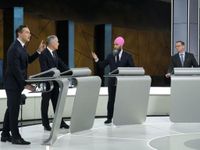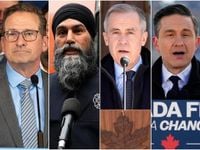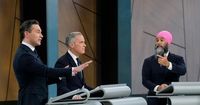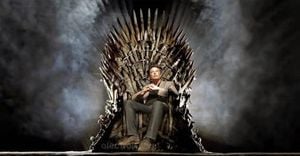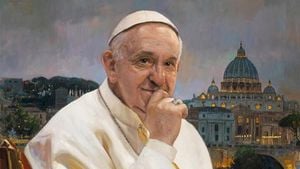As Canada prepares for its federal election on April 28, 2025, the political landscape is heating up. Leaders of the four main political parties—Liberal Mark Carney, Conservative Pierre Poilievre, NDP Jagmeet Singh, and Bloc Quebecois Yves-François Blanchet—recently faced off in two pivotal debates aimed at swaying undecided voters. The debates, conducted in both English and French, were marked by sharp exchanges on key issues such as the high cost of living, U.S. President Donald Trump's trade policies, and the future of Canadian sovereignty.
The English-language debate saw all leaders agree on the necessity of strengthening Canada’s domestic economy, with the high cost of living emerging as a recurrent theme. Poilievre, in particular, capitalized on the economic anxieties of Canadians, framing his arguments around a decade of Liberal failures. "Many of you are worried about paying your bills, feeding your families or ever even owning a home," he stated, appealing to the everyday concerns of voters.
Meanwhile, Carney, who has only been in office for a month, faced significant scrutiny from his opponents. Despite being the target of numerous attacks, he maintained his composure, often redirecting the conversation back to his experience managing economic crises. He warned Canadians about the implications of Trump’s presidency, asserting, "He’s trying to break us so they can own us." This message resonated with many voters who are concerned about U.S.-Canada relations under Trump's administration.
The debates were not without their lighter moments. The leaders even jokingly discussed giving up American strawberries to promote Canadian produce, showcasing a lighter side amid serious discussions. However, the atmosphere was tense, especially as security concerns led to the cancellation of post-debate news conferences.
In the French-language debate, the focus shifted to the specifics of Trump's trade war. Leaders exchanged barbs about their strategies for navigating these turbulent waters. Singh, known for his energetic style, often interrupted his opponents, a tactic he defended as necessary to challenge their positions. "I’m a scrappy guy, I want to fight for people," he remarked, justifying his aggressive approach during the debates.
Analysts observed that while the debates provided a platform for leaders to showcase their policies, they also highlighted the divide in strategies among the parties. Poilievre and Blanchet were noted as having strong performances, with Poilievre successfully presenting himself as a viable alternative to Carney. Columnist Keith Gerein remarked, "Poilievre was particularly effective in his criticisms of the Liberal record on crime and public safety," suggesting that his approach may resonate with voters concerned about safety and economic stability.
Despite the strong performances from Poilievre and Blanchet, Carney managed to hold his ground. He sought to differentiate himself from former Prime Minister Justin Trudeau, emphasizing that he is not merely a continuation of the past. However, his performance was critiqued for being overly cautious, with some analysts questioning his ability to connect emotionally with voters.
Polling data reflects the shifting dynamics of the election. A recent Ipsos poll indicated that while the Liberals initially gained ground due to fears surrounding Trump, they have since lost some of that momentum, with the Conservatives narrowing the gap. Young voters, particularly those aged 18 to 34, are seen as a crucial demographic, with nearly half indicating they could still be swayed before election day.
As the campaign progresses, the leaders are ramping up their efforts to engage these younger voters. Digital ad analyses reveal that while the Conservatives are focusing on appealing to Gen Z and Millennials, the Liberals are targeting older voters and those in Francophone regions. This demographic strategy could play a pivotal role in the outcome of the election.
Looking ahead, the race remains tight. With advance voting beginning soon, the leaders are expected to hit the campaign trail hard. Carney's strategy appears to hinge on maintaining his lead while addressing the pressing concerns of Canadians regarding affordability and national security. Singh, on the other hand, must find a way to regain traction among progressive voters who seem to be flocking to Carney's camp.
As the debates wrap up, the question remains: who will ultimately win the hearts and minds of Canadian voters? With the election just days away, the focus will be on how effectively each leader can translate their debate performances into votes.
